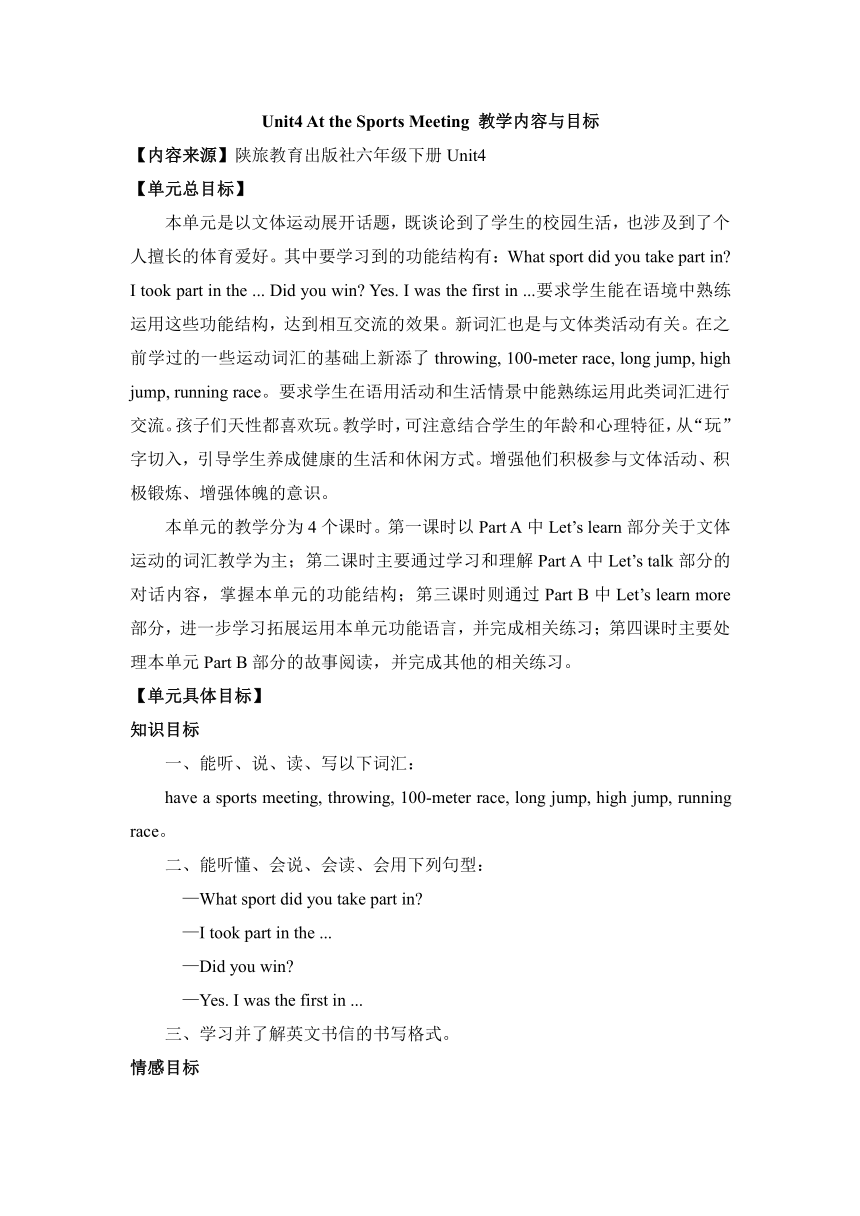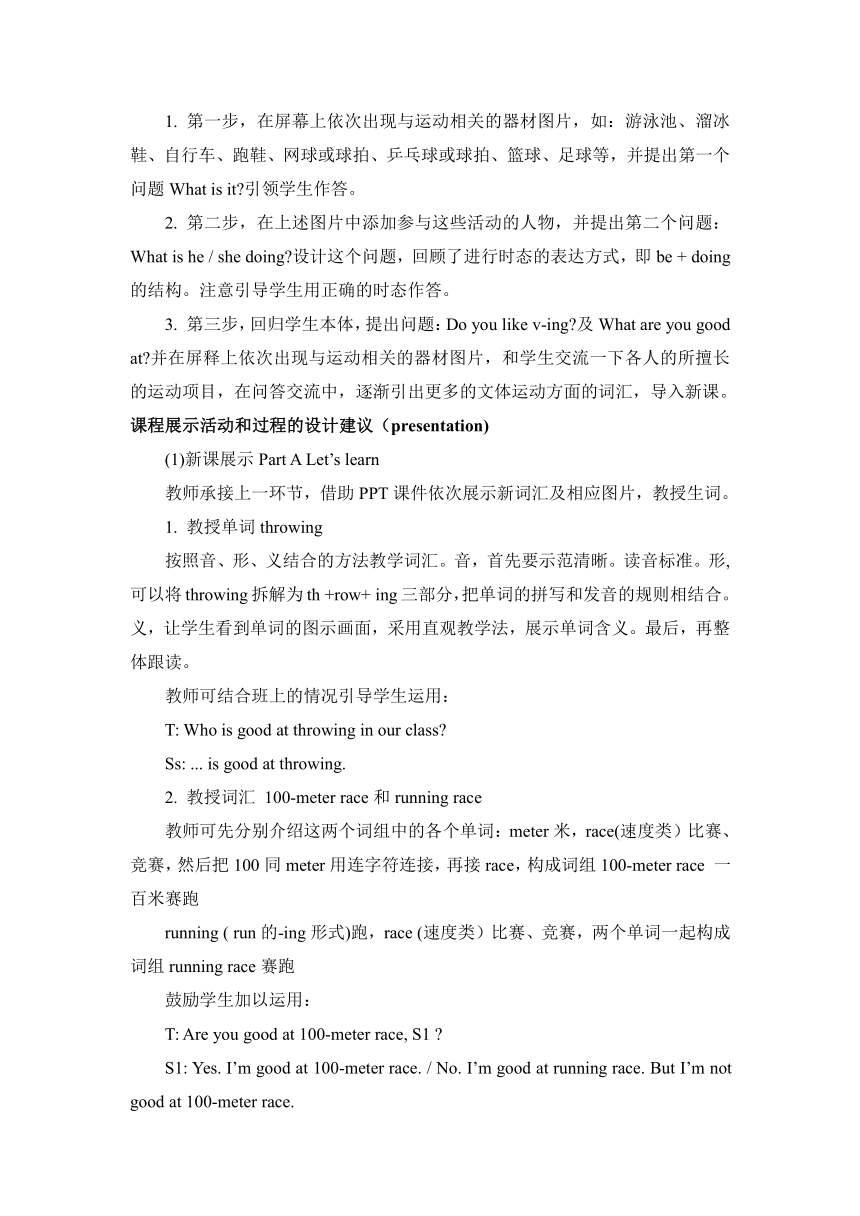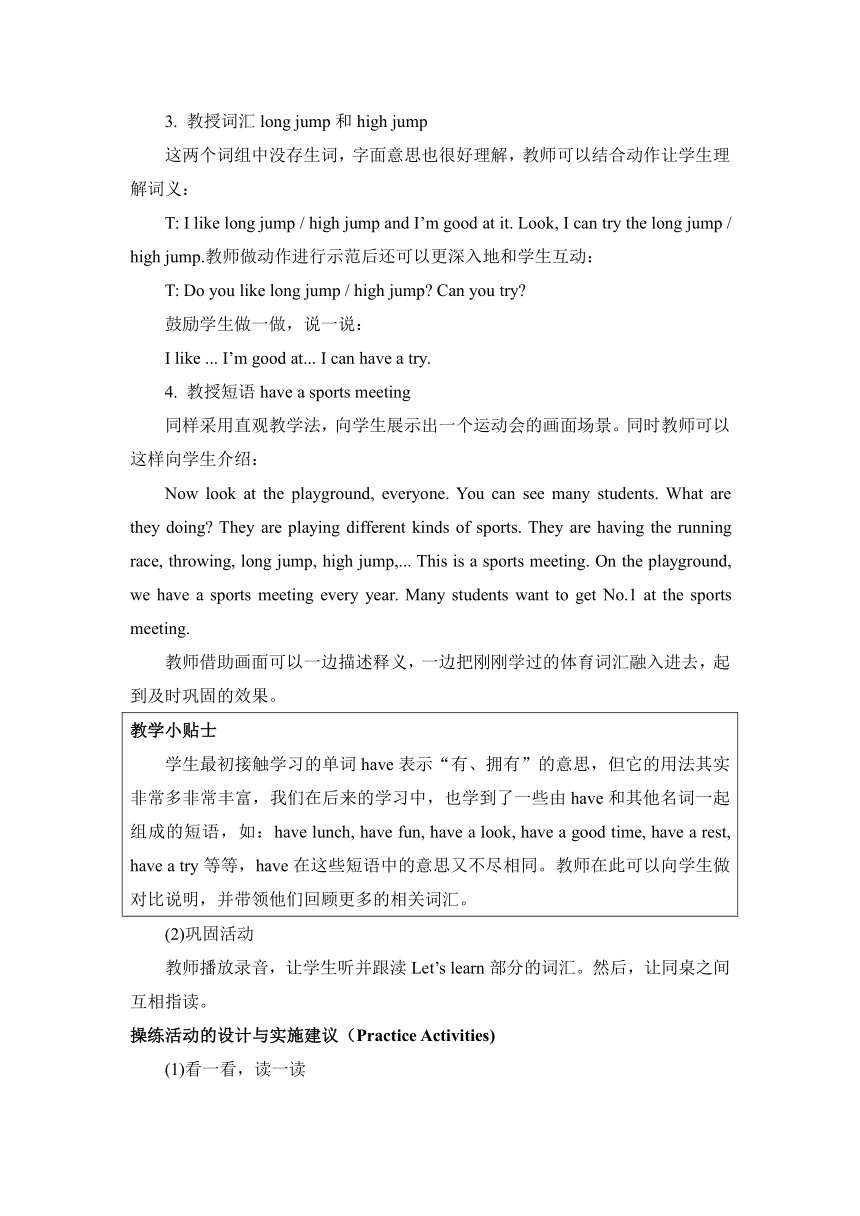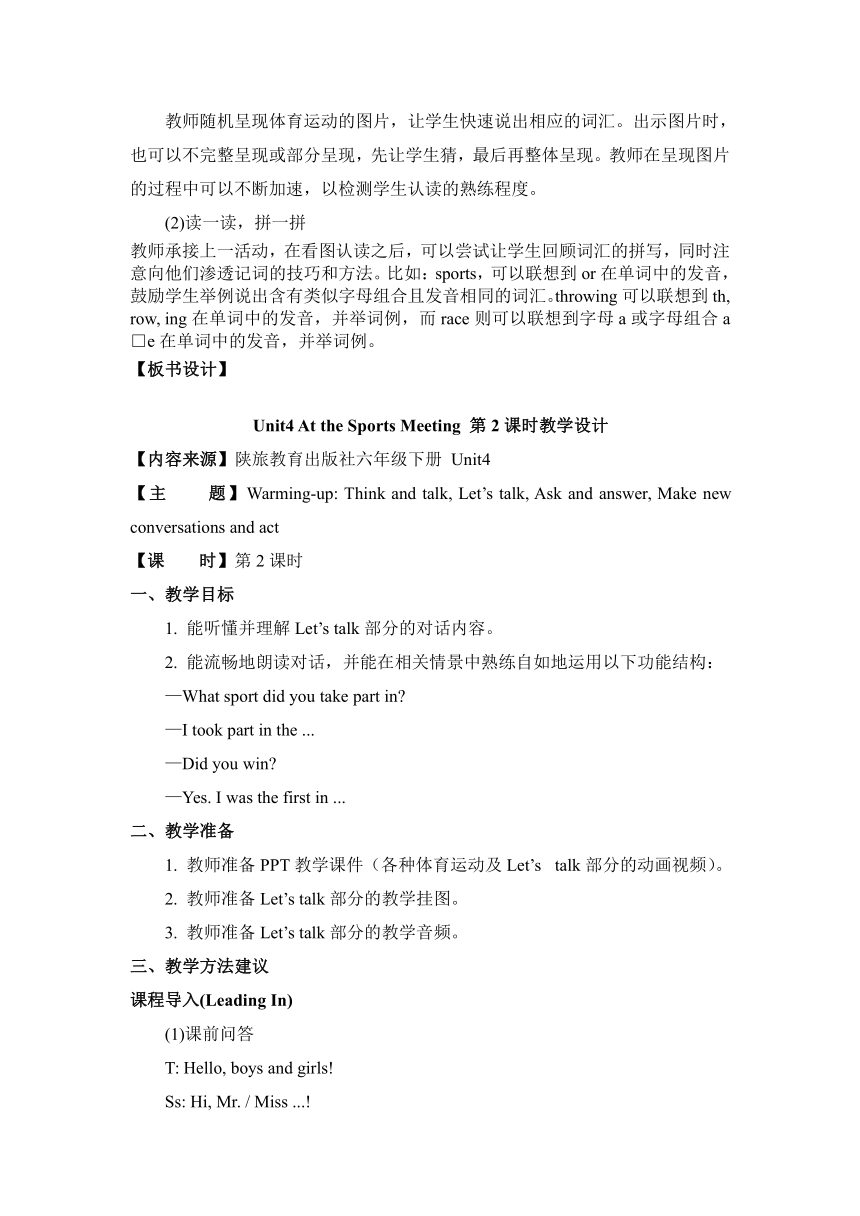Unit 4 At the Sports Meeting 单元教案(4个课时)
文档属性
| 名称 | Unit 4 At the Sports Meeting 单元教案(4个课时) |  | |
| 格式 | zip | ||
| 文件大小 | 47.5KB | ||
| 资源类型 | 教案 | ||
| 版本资源 | 陕旅版 | ||
| 科目 | 英语 | ||
| 更新时间 | 2018-01-27 21:47:01 | ||
图片预览





文档简介
Unit4 At the Sports Meeting 教学内容与目标
【内容来源】陕旅教育出版社六年级下册Unit4
【单元总目标】
本单元是以文体运动展开话题,既谈论到了学生的校园生活,也涉及到了个人擅长的体育爱好。其中要学习到的功能结构有:What sport did you take part in? I took part in the ... Did you win? Yes. I was the first in ...要求学生能在语境中熟练运用这些功能结构,达到相互交流的效果。新词汇也是与文体类活动有关。在之前学过的一些运动词汇的基础上新添了throwing, 100-meter race, long jump, high jump, running race。要求学生在语用活动和生活情景中能熟练运用此类词汇进行交流。孩子们天性都喜欢玩。教学时,可注意结合学生的年龄和心理特征,从“玩”字切入,引导学生养成健康的生活和休闲方式。增强他们积极参与文体活动、积极锻炼、增强体魄的意识。
本单元的教学分为4个课时。第一课时以Part A中Let’s learn部分关于文体运动的词汇教学为主;第二课时主要通过学习和理解Part A中Let’s talk部分的对话内容,掌握本单元的功能结构;第三课时则通过Part B中Let’s learn more部分,进一步学习拓展运用本单元功能语言,并完成相关练习;第四课时主要处理本单元Part B部分的故事阅读,并完成其他的相关练习。
【单元具体目标】
知识目标
一、能听、说、读、写以下词汇:
have a sports meeting, throwing, 100-meter race, long jump, high jump, running race。
二、能听懂、会说、会读、会用下列句型:
—What sport did you take part in?
—I took part in the ...
—Did you win?
—Yes. I was the first in ...
三、学习并了解英文书信的书写格式。
情感目标
一、培养和发展学生的个性。引导学生养成积极参加体育锻炼的好习惯,培养其发展有益身心健康的兴趣爱好。
二、培养学生的团队合作意识和集体荣誉感。
三、不断提高学生学习英语的热情,鼓励学生积极主动地参与课堂活动,大胆开口,主动交流。
Unit4 At the Sports Meeting 第1课时教学设计
【内容来源】陕旅教育出版社六年级下册 Unit4
【主 题】Warming-up: Look and tick, Let’s learn
【课 时】第1课时
一、教学目标
1. 能听、说、读、写词汇:have a sports meeting, throwing, 100-meter race, long jump, high jump, running race。
2. 能说出自己最喜欢的或擅长的体育运动的名称。
3. 鼓励学生积极参与体育运动,培养体育兴趣或爱好。
二、教学准备
1. 教师准备Let’s learn部分的词汇教学卡片。
2. 教师准备PPT教学课件。
3. 教师准备Let’s learn部分的教学音频。
三、教学方法建议
课程导入(Leading In)
(1)课前问答
T: In the morning, many people like running and doing some exercise. Do you often do exercise? What kind of exercise do you like?
S1: I like playing football.
S2:I like playing ping-pong.
...
(2)新课导入Part A Warming-up: Look and tick
以此部分内容引入新课时,教师可以设计以下梯度练习:
1. 第一步,在屏幕上依次出现与运动相关的器材图片,如:游泳池、溜冰鞋、自行车、跑鞋、网球或球拍、乒乓球或球拍、篮球、足球等,并提出第一个问题What is it?引领学生作答。
2. 第二步,在上述图片中添加参与这些活动的人物,并提出第二个问题:What is he / she doing?设计这个问题,回顾了进行时态的表达方式,即be + doing的结构。注意引导学生用正确的时态作答。
3. 第三步,回归学生本体,提出问题:Do you like v-ing?及What are you good at?并在屏释上依次出现与运动相关的器材图片,和学生交流一下各人的所擅长的运动项目,在问答交流中,逐渐引出更多的文体运动方面的词汇,导入新课。
课程展示活动和过程的设计建议(presentation)
(1)新课展示Part A Let’s learn
教师承接上一环节,借助PPT课件依次展示新词汇及相应图片,教授生词。
1. 教授单词throwing
按照音、形、义结合的方法教学词汇。音,首先要示范清晰。读音标准。形,可以将throwing拆解为th +row+ ing三部分,把单词的拼写和发音的规则相结合。义,让学生看到单词的图示画面,采用直观教学法,展示单词含义。最后,再整体跟读。
教师可结合班上的情况引导学生运用:
T: Who is good at throwing in our class?
Ss: ... is good at throwing.
2. 教授词汇 100-meter race和running race
教师可先分别介绍这两个词组中的各个单词:meter米,race(速度类)比赛、竞赛,然后把100同meter用连字符连接,再接race,构成词组100-meter race 一百米赛跑
running ( run的-ing形式)跑,race (速度类)比赛、竞赛,两个单词一起构成词组running race赛跑
鼓励学生加以运用:
T: Are you good at 100-meter race, S1 ?
S1: Yes. I’m good at 100-meter race. / No. I’m good at running race. But I’m not good at 100-meter race.
3. 教授词汇long jump和high jump
这两个词组中没存生词,字面意思也很好理解,教师可以结合动作让学生理解词义:
T: I like long jump / high jump and I’m good at it. Look, I can try the long jump / high jump.教师做动作进行示范后还可以更深入地和学生互动:
T: Do you like long jump / high jump? Can you try?
鼓励学生做一做,说一说:
I like ... I’m good at... I can have a try.
4. 教授短语have a sports meeting
同样采用直观教学法,向学生展示出一个运动会的画面场景。同时教师可以这样向学生介绍:
Now look at the playground, everyone. You can see many students. What are they doing? They are playing different kinds of sports. They are having the running race, throwing, long jump, high jump,... This is a sports meeting. On the playground, we have a sports meeting every year. Many students want to get No.1 at the sports meeting.
教师借助画面可以一边描述释义,一边把刚刚学过的体育词汇融入进去,起到及时巩固的效果。
教学小贴士
学生最初接触学习的单词have表示“有、拥有”的意思,但它的用法其实非常多非常丰富,我们在后来的学习中,也学到了一些由have和其他名词一起组成的短语,如:have lunch, have fun, have a look, have a good time, have a rest, have a try等等,have在这些短语中的意思又不尽相同。教师在此可以向学生做对比说明,并带领他们回顾更多的相关词汇。
(2)巩固活动
教师播放录音,让学生听并跟渎Let’s learn部分的词汇。然后,让同桌之间互相指读。
操练活动的设计与实施建议(Practice Activities)
(1)看一看,读一读
教师随机呈现体育运动的图片,让学生快速说出相应的词汇。出示图片时,也可以不完整呈现或部分呈现,先让学生猜,最后再整体呈现。教师在呈现图片的过程中可以不断加速,以检测学生认读的熟练程度。
(2)读一读,拼一拼
教师承接上一活动,在看图认读之后,可以尝试让学生回顾词汇的拼写,同时注意向他们渗透记词的技巧和方法。比如:sports,可以联想到or在单词中的发音,鼓励学生举例说出含有类似字母组合且发音相同的词汇。throwing可以联想到th, row, ing在单词中的发音,并举词例,而race则可以联想到字母a或字母组合a□e在单词中的发音,并举词例。
【板书设计】
Unit4 At the Sports Meeting 第2课时教学设计
【内容来源】陕旅教育出版社六年级下册 Unit4
【主 题】Warming-up: Think and talk, Let’s talk, Ask and answer, Make new conversations and act
【课 时】第2课时
一、教学目标
1. 能听懂并理解Let’s talk部分的对话内容。
2. 能流畅地朗读对话,并能在相关情景中熟练自如地运用以下功能结构:
—What sport did you take part in?
—I took part in the ...
—Did you win?
—Yes. I was the first in ...
二、教学准备
1. 教师准备PPT教学课件(各种体育运动及Let’s talk部分的动画视频)。
2. 教师准备Let’s talk部分的教学挂图。
3. 教师准备Let’s talk部分的教学音频。
三、教学方法建议
课程导入(Leading In)
(1)课前问答
T: Hello, boys and girls!
Ss: Hi, Mr. / Miss ...!
T: Look! What am I doing?(做踢球动作)
Ss: You are playing football.
T: Do you like playing football?
Ss: Yes. / No.
T: What sport do you like?
Ss: I like ...
...
(2)新课导入Part A Warming-up: Think and talk
教师承接上一环节,借助PPT上呈现各种体育运动的画面,让学生看画面说出相关的体育词汇。同时,可以引入本部分的对话,继续深入与学生交流What’s your favorite sport? How often do you play it?等等,并引导学生作答,为对话的讲授做铺垫。
课程展示活动和过程的设计建议(presentation)
(1)新课展示Part A: Let’s talk
1. 教师展示Let’s talk部分的挂图,引导学生仔细观察图画,并就画面进行交流:
T: Look at the picture. Who is the boy?
Ss: He is Liu Zhaoyang.
T: And the girl is Amy. What are they talking about?
Ss. They are talking about the sports meeting.
T: Yes. They had a school sports meeting yesterday. It was a great sports meeting. Do you want to know something about the school sports meeting? Who was the first in the 100-meter race? Please watch the video carefully.
2. 教师播放Let’s talk部分的教学视频,让学生认真观看,了解对话内容中所谈到的人物以及事情的发展情况。并提出如下问题,以检验学生们的理解情况:
(1) How does Liu Zhaoyang look? Why?
(2) What did he do at the sports meeting?
(3) Who was the first in the 100-meter race?
3. 让学生打开课本,边朗读对话边在课本上勾画出上述问题的答案,之后教师帮助学生回答问题:
Liu looks tired because he took part in the boys’ 100-meter race and the long jump at the school sports meeting yesterday. And he was the first in the 100- meter race.
4. 教师引导并帮助学生理解对话的完整内容,并重点讲解took part in和I was the first in ... 以及单词lost和anyway。
(1) take (took) part in“参加”,教师可通过举例帮助学生理解运用。
如:Everybody can take part in the school sports meeting.
We all took part in the New Year’s party last year.
(2) I am (was) the first in ...在某项活动中(曾)名列第一。
教师可结合班上学生在活动中的表现,鼓励学生说:
Who was the first in the swimming?
Which class is the first in the football match?
教学小贴士
join和take part in二者都有“参加”的意思,但用法有所不同。
join多指参加某组织成为其中的一个成员,如加入某党派、某组织或某社会团体,以及参军等,也可指参与某种活动。如:
Let’s join the Wild Animals Protect Association.
Will you join us in the game?
而take part in则指参加群众性活动、会议、劳动、游行等,往往指参与者持有积极的态度,又可与join in互换。如:We should take part in class activities.
(3) lost是单词lose的过去式,有“丟失、失利”等意思,其反义同是win。lose the game/match/... 是“输了比赛”,win the game / match / ... 则指“贏了比赛”。
(4) anyway “不管怎样”,常用来表示在得知了某些情况之后要得出一个结论,转向下一个主题。如:They lost the game in the sports meeting. Anyway, they tried their best.
5. 教师播放Let’s talk部分的录音,让学生看课本,再听一遍对话。然后跟随教师的示范朗读对话。含有过去式的句子一般比较难读,教师可注意指导学生正确朗读的方法。必要时带领学生回顾几个特殊的动词过去式,如:have—had, take—took, am/is—was, lose—lost, do—did。
(2)巩固活动
1. 教师再次播放Let’s talk部分的录音,学生模仿其语音语调跟读对话。
2. 同桌之间进行角色朗读,注意语音、语调和语气。之后,教师可以通过几组学生的演读展示,进行朗读指导与评价。
操练活动的设计与实施建议(Practice Activities)
(1)Part B Ask and answer
1. 教师引导学生观察讨论本部分的图片,并说出相应的运动名称:
T: Look at this picture. What sport is it?
Ss: Throwing.
T: What sport is it in the last picture?
Ss: It’s a running race.
2. 看图,参考本部分的对话范例进行模仿、替换练习,如:
A: What sport did he / she take part in at the school sports meeting?
B: He / She took part in ...
A: Did he / she win it?
B: Yes, he / she did./ No, he / she didn’t. He / She lost it.
开始时,教师可先参与“问”,由学生来回答。然后渐渐将重心转向学生,学生之间一问一答。
(2)Part B Make new conversations and act
把学生分为若干小组,在小组内每位学生讨论自己要在运动会参加什么项目。
1. 先由一个学生充当小组长或体育委员,询问本组内的每位学生在运动会要参加什么项目,并做记录。
2. 第二个学生到下一个组去,询问该组内的每位学生在运动会上要参加什么项目,并做记录。
3. 每位学生依次循环交替到其他组进行类似的会话活动。
4. 学生根据搜集到的信息自主完成对话创编。教师注意鼓励学生拓展、创新,在对话中涉及更多的体育运动项目,并给予指导和积极的评价。
【板书设计】
Unit4 At the Sports Meeting 第3课时教学设计
【内容来源】陕旅教育出版社六年级下册 Unit4
【主 题】Let’s learn more, Listen and match, Choose and complete
【课 时】第3课时
一、教学目标
1. 能听懂并理解Let’s learn more部分的内容,并准确完成课后判断练习。
2. 能较为流利地朗读课文内容,要求语音、语调正确。
3. 学习并了解英文书信的书写格式。
二、教学准备
1. 教师准备Let’s learn more部分的学挂图和一幅在操场进行体育活动的图。
2. 教师准备PPT教学课件(各种体育运动)。
3. 教师准备Let’s learn more和Listen and match部分的教学音频。
三、教学方法建议
课程导入(Leading In)
(1)课前问答
T: Hello, boys and girls!
Ss: Hi, Mr. / Miss ...!
T: Playing sports is good for your health.(呈现在操场上进行体育活动的图)
Look! So many people are playing sports. What sports are they playing?
Ss: They are ...
(2)新课导入
教师展示各种体育运动的PPT教学课件,引导学生观察、谈论,可以这样介绍:
T: We had a sports meeting last week. Look, what did our class take part in?
Ss: We took part in ...
课程展示活动和过程的设计建议(presentation)
(1)新课展示Part B Let’s learn more
1. 教师承接上一环节,引出新课;教师可以慢慢地讲述,让尽量多的学生听懂、了解这段课文的基本背景:
T: Do you still remember our friend Wu Chen? Wu Chen s school had a sports meeting last week. All her classmates were very excited. Because her class did very well in the sports meeting. Wu Chen is writing a letter to her friend Ma Li. She is telling her about it. Now please listen carefully and see what she is telling Ma Li.
2. 播放Let’s learn more部分的录音,要求学生认真听,通过“听”到的信息,对课文内容有一个大概的了解。在听的过程中,教师可请学生说出听到了哪些关键词汇和句子,或所听段落的主要内容是什么,从而提高学生的听力水平。教师可借助本部分课文训练学生学会抓住关键词和主要句子,逐步掌握听的学习策略。比如,在学生听完这个部分的录音后,首先学生会听到Dear Ma Li这样的称呼,还有最后的落款:Yours Wu Chen。由此,教师可介绍此文题材是一封写给朋友的信件,并引导学生抓取信件里一些主要的相关信息。如:a sports meeting, last week, Wu Chen’s class did very well, Li Shan ..., Colin ... 及信件中所描述的运动会的一些相关情况。
3. 听录音后,教师可以设计相关提问,检测学生“听”的效果。如:
(1) When was the sports meeting?
(2) How was the weather?
(3) Who won the girls’ throwing?
(4) Who won the boys’100-meter race?
(5) In which sport was Li Shan the first?
(6) What sport did Colin take part in? Did he win?
4. 教师引领学生通读课文,帮助他们完整理解整个信件内容。并对文中的一些难点做必要的讲解,鼓励学生加以运用。
(1) excited“兴奋的”,常见搭配有be/feel excited,如:
The girl was very excited because she saw her favorite singer.
They won the football game. So all of them felt excited
(2) do well (in) “(在……)做得好”,如:
Wu Min did very well. We should learn from him.
My sister does very well in her work. And her students like her very much.
(3) shout“大喊”,如:Don’t shout at me.
(4) finally“最终”,如:Finally, they lost the game.
教学小贴士
在某些情况下,do well in (doing) something = be good at (doing) something,两者都可以表示“擅长(做)某事”,可以替换。如:She does well in swimming. = She is good at swimming.
5. 结合课文,向学生们介绍英文书信的书写格式。
_____A______
I’m happy your class did well in the sports meeting. We will have our sports meeting next week. We usually have it in April. But this time we’ll have it in May. Because the weather was so bad in April.
_____B______
_____ C______
_____ D______
A.称谓 B.祝福语 C.结束语 D.署名
教师在这里可简单补充介绍一下英文信封的书写格式,如:
(2)巩固活动
1. 教师播放录音,学生打开课本模仿其语音语调指读课文。
2. Read again and tick or cross
先让学生朗读本部分的五个句子,并画出各句中的关键词,如:
(1) Ma Li’s school had a sports meeting last week.
(2) Wu Chen was from Class Three and Colin was from Class One.
(3) Liu Zhaoyang ran very fast.
(4) Kitty won the girls’ high jump.
(5) Colin was the first in the boys’ 1500-meter race.
再让学生自主阅读课文并在文中划出含有相关信息的句子。然后,让学 生完成判断:最后组织学生一起核对答案,并改正句子中的错误信息。
参考答案:1.× 2.× 3.√ 4.× 5.√
操练活动的设计与实施建议(Practice Activities)
(1)Part C Listen and match
1. 先让学生自主熟悉文本信息:人物和运动项目。
2. 播放录音,让学生自听一两遍,根据听到的内容完成连线。
3. 回放录音并逐句理解,学生自检答案是否正确,并订正错误。
4. 随机选出几名学生根据各自的连线结果说一说完整的句子,或将运动项目贴在黑板上,然后选出4名学生分别代表4位人物站到相应的位置,以此方式来核对答案。
本部分的录音内容如下:
Tina’s school had a sports meeting last week. Tina’s class did well in it. First, Peter won the boys’ 60-meter race and Lily won the girls’ 200-meter race. Then Tina won the girls’ high jump and Kevin was the first in the boys’ throwing. All the students were excited.
参考答案:1-D, 2-C, 3-A, 4-B
(2)Part C Choose and complete
学生可以根据之前讲过的书信格式,搞清楚哪里是称呼语,哪里是结束语,然后自主选择,完成本部分书信格式的填写练习。本次课后,教师可以尝试宣布一个练笔任务,让学生自主选择话题写一封信,锻炼其“写用”能力。
参考答案:③ ② ① ④
【板书设计】
Unit4 At the Sports Meeting 第4课时教学设计
【内容来源】陕旅教育出版社六年级下册 Unit4
【主 题】Read a story, Order and act, Read and choose
【课 时】第4课时
一、教学目标
1. 能听懂并理解Read a story部分的内容,并能熟练地朗读故事。
2. 能独立完成Part C部分所剩余的练习。
3. 培养学生的体育意识,引导学生养成良好的学习习惯。
二、教学准备
1. 教师准备Read a story部分的教学视频课件。
2. 教师准备PPT课件(运动会场景)或教学挂图。
3. 教师准备录音机以及Read a story部分的教学音频。
三、教学方法建议
课程导入(Leading In)
(1)课前问答
T: Nice to see you!
Ss: Nice to see you, too!
T: Did you watch the Olympic Games on TV?
Ss: Yes.
T: What sport did you watch?
S1: I watched basketball, swimming, ...
S2: I watched ...
(2)新课导入
1. 教师借助PPT展示sports meeting的图画,让学生看图描述运动场上的场景。教师可以这样引导:
What can you see from the picture?
What kind of sports do the pupils take part in?
Look at the players. What are they doing now?
Look at the other pupils. How are they feeling?
随机选取学生描述运动会场景,教师在必要时可引导学生尽可能多地运用已学过的功能结构进行完整的表达。对描述熟练,语言丰富的学生给予表扬,并对需要帮助的学生给予积极的指导鼓励,树立其信心。
2. 学生完成sports meeting的场景描述后,教师可顺势将话题引入到今天将要了解学习的故事。可以这样描述一个场景:
T: Boys and girls, there were many animals in the forest. They had a sports meeting, too. Let’s have a look at their sports meeting.
课程展示活动和过程的设计建议(presentation)
(1)Part B Read a story
1. 引故事:Many animals took part in the sports meeting. Who were they? What sport did they take part in at the sports meeting? Let’s listen to the tape now.
2. 听故事:教师播放本部分的录音,让学生通过“听”的输入了解故事大意。教师可以请学生说一说听到有哪些动物、哪些词汇或哪些句子,帮助学生理解。
3. 看故事:教师播放所准备的本部分的教学视频,让学生观看完整的故事情节。画面与声音的结合,能促进学生更直观地理解故事内容。
4. 读故事:学生自己读完一遍故事,并在奋疑惑的地方做标注。要求出声读,以锻炼学生的语音及阅读能力。
5. 解疑惑:教师可注意就at first, high等词汇释疑,并适当解说故事主旨句We’d better play sports every day. Let’s be faster, higher and stronger.教师在此可适当进行情感渗透,培养学生的体育意识,引导学生养成劳逸结合的良好学习习惯。
教学小贴士
’d better do = had better do“最好做某事”,如:Stop playing computer games, Nick! You’d better do your homework first.
6. 练一练:
将学生分为若干小组,并在组内分段分任务进行故事朗读活动,以此来锻炼学生的语音、语调和朗读能力。然后随机指出几组学生进行朗读表演,并给予适度的指导和积极的评价。
(2)Part C Order and act
1. 让学生朗读句子,熟悉句意。
2. 自主完成句子排序,注意要使语意流畅通顺、符合逻辑。
3. 随机选出几组同桌的学生,让他们根据其排序结果分角色朗读。
参考答案:2,3,5,1,4,6
(3)Part C Read and choose
1. 先让学生熟悉方框中的词汇,并让他们说一说其中动词的过去式。
2. 学生自主默读对话,边读边试着将所缺的词汇填入。
3. 把全班学生分做A、B两部分齐声朗读对话。
参考答案:when, take, jump, boys, win, about, first, well
操练活动的设计与实施建议(Practice Activities)
(1)做一做,猜一猜
教师请几个学生分别做动作,其他学生猜测相关运动的词汇,复习与本单元话题内容有关的词汇。教师可以这样介绍:In our class, many students like playing sports. Next, I’ll ask someone to do actions about sports. Please guess and tell what sport it is. Now please pay attention.
教师也可以要求学生在猜出词汇的同时拼写词汇,检测学生的词汇记忆情况。
(2)说一说
首先,以PPT画面呈现与本单元体育运动话题相关的词汇及其配图,让学生描述各自的体育爱好。教师可以这样引导:Now, everyone. Please tell me about your favorite sport. You can look at the pictures and think about them. Then tell us what sport you want to take part in at our school sports meeting.
教师可以在屏幕上向学生提示可以运用的功能结构,如:I like ... My favorite sport is ... I’m good at ... I want to take part in ... at our school sports meeting.等等。
在此环节中,教师要注意积极评价语言表达较为丰富的学生,并鼓励更多的学生勇于开口,积极表达。
教学笔记
【板书设计】
【内容来源】陕旅教育出版社六年级下册Unit4
【单元总目标】
本单元是以文体运动展开话题,既谈论到了学生的校园生活,也涉及到了个人擅长的体育爱好。其中要学习到的功能结构有:What sport did you take part in? I took part in the ... Did you win? Yes. I was the first in ...要求学生能在语境中熟练运用这些功能结构,达到相互交流的效果。新词汇也是与文体类活动有关。在之前学过的一些运动词汇的基础上新添了throwing, 100-meter race, long jump, high jump, running race。要求学生在语用活动和生活情景中能熟练运用此类词汇进行交流。孩子们天性都喜欢玩。教学时,可注意结合学生的年龄和心理特征,从“玩”字切入,引导学生养成健康的生活和休闲方式。增强他们积极参与文体活动、积极锻炼、增强体魄的意识。
本单元的教学分为4个课时。第一课时以Part A中Let’s learn部分关于文体运动的词汇教学为主;第二课时主要通过学习和理解Part A中Let’s talk部分的对话内容,掌握本单元的功能结构;第三课时则通过Part B中Let’s learn more部分,进一步学习拓展运用本单元功能语言,并完成相关练习;第四课时主要处理本单元Part B部分的故事阅读,并完成其他的相关练习。
【单元具体目标】
知识目标
一、能听、说、读、写以下词汇:
have a sports meeting, throwing, 100-meter race, long jump, high jump, running race。
二、能听懂、会说、会读、会用下列句型:
—What sport did you take part in?
—I took part in the ...
—Did you win?
—Yes. I was the first in ...
三、学习并了解英文书信的书写格式。
情感目标
一、培养和发展学生的个性。引导学生养成积极参加体育锻炼的好习惯,培养其发展有益身心健康的兴趣爱好。
二、培养学生的团队合作意识和集体荣誉感。
三、不断提高学生学习英语的热情,鼓励学生积极主动地参与课堂活动,大胆开口,主动交流。
Unit4 At the Sports Meeting 第1课时教学设计
【内容来源】陕旅教育出版社六年级下册 Unit4
【主 题】Warming-up: Look and tick, Let’s learn
【课 时】第1课时
一、教学目标
1. 能听、说、读、写词汇:have a sports meeting, throwing, 100-meter race, long jump, high jump, running race。
2. 能说出自己最喜欢的或擅长的体育运动的名称。
3. 鼓励学生积极参与体育运动,培养体育兴趣或爱好。
二、教学准备
1. 教师准备Let’s learn部分的词汇教学卡片。
2. 教师准备PPT教学课件。
3. 教师准备Let’s learn部分的教学音频。
三、教学方法建议
课程导入(Leading In)
(1)课前问答
T: In the morning, many people like running and doing some exercise. Do you often do exercise? What kind of exercise do you like?
S1: I like playing football.
S2:I like playing ping-pong.
...
(2)新课导入Part A Warming-up: Look and tick
以此部分内容引入新课时,教师可以设计以下梯度练习:
1. 第一步,在屏幕上依次出现与运动相关的器材图片,如:游泳池、溜冰鞋、自行车、跑鞋、网球或球拍、乒乓球或球拍、篮球、足球等,并提出第一个问题What is it?引领学生作答。
2. 第二步,在上述图片中添加参与这些活动的人物,并提出第二个问题:What is he / she doing?设计这个问题,回顾了进行时态的表达方式,即be + doing的结构。注意引导学生用正确的时态作答。
3. 第三步,回归学生本体,提出问题:Do you like v-ing?及What are you good at?并在屏释上依次出现与运动相关的器材图片,和学生交流一下各人的所擅长的运动项目,在问答交流中,逐渐引出更多的文体运动方面的词汇,导入新课。
课程展示活动和过程的设计建议(presentation)
(1)新课展示Part A Let’s learn
教师承接上一环节,借助PPT课件依次展示新词汇及相应图片,教授生词。
1. 教授单词throwing
按照音、形、义结合的方法教学词汇。音,首先要示范清晰。读音标准。形,可以将throwing拆解为th +row+ ing三部分,把单词的拼写和发音的规则相结合。义,让学生看到单词的图示画面,采用直观教学法,展示单词含义。最后,再整体跟读。
教师可结合班上的情况引导学生运用:
T: Who is good at throwing in our class?
Ss: ... is good at throwing.
2. 教授词汇 100-meter race和running race
教师可先分别介绍这两个词组中的各个单词:meter米,race(速度类)比赛、竞赛,然后把100同meter用连字符连接,再接race,构成词组100-meter race 一百米赛跑
running ( run的-ing形式)跑,race (速度类)比赛、竞赛,两个单词一起构成词组running race赛跑
鼓励学生加以运用:
T: Are you good at 100-meter race, S1 ?
S1: Yes. I’m good at 100-meter race. / No. I’m good at running race. But I’m not good at 100-meter race.
3. 教授词汇long jump和high jump
这两个词组中没存生词,字面意思也很好理解,教师可以结合动作让学生理解词义:
T: I like long jump / high jump and I’m good at it. Look, I can try the long jump / high jump.教师做动作进行示范后还可以更深入地和学生互动:
T: Do you like long jump / high jump? Can you try?
鼓励学生做一做,说一说:
I like ... I’m good at... I can have a try.
4. 教授短语have a sports meeting
同样采用直观教学法,向学生展示出一个运动会的画面场景。同时教师可以这样向学生介绍:
Now look at the playground, everyone. You can see many students. What are they doing? They are playing different kinds of sports. They are having the running race, throwing, long jump, high jump,... This is a sports meeting. On the playground, we have a sports meeting every year. Many students want to get No.1 at the sports meeting.
教师借助画面可以一边描述释义,一边把刚刚学过的体育词汇融入进去,起到及时巩固的效果。
教学小贴士
学生最初接触学习的单词have表示“有、拥有”的意思,但它的用法其实非常多非常丰富,我们在后来的学习中,也学到了一些由have和其他名词一起组成的短语,如:have lunch, have fun, have a look, have a good time, have a rest, have a try等等,have在这些短语中的意思又不尽相同。教师在此可以向学生做对比说明,并带领他们回顾更多的相关词汇。
(2)巩固活动
教师播放录音,让学生听并跟渎Let’s learn部分的词汇。然后,让同桌之间互相指读。
操练活动的设计与实施建议(Practice Activities)
(1)看一看,读一读
教师随机呈现体育运动的图片,让学生快速说出相应的词汇。出示图片时,也可以不完整呈现或部分呈现,先让学生猜,最后再整体呈现。教师在呈现图片的过程中可以不断加速,以检测学生认读的熟练程度。
(2)读一读,拼一拼
教师承接上一活动,在看图认读之后,可以尝试让学生回顾词汇的拼写,同时注意向他们渗透记词的技巧和方法。比如:sports,可以联想到or在单词中的发音,鼓励学生举例说出含有类似字母组合且发音相同的词汇。throwing可以联想到th, row, ing在单词中的发音,并举词例,而race则可以联想到字母a或字母组合a□e在单词中的发音,并举词例。
【板书设计】
Unit4 At the Sports Meeting 第2课时教学设计
【内容来源】陕旅教育出版社六年级下册 Unit4
【主 题】Warming-up: Think and talk, Let’s talk, Ask and answer, Make new conversations and act
【课 时】第2课时
一、教学目标
1. 能听懂并理解Let’s talk部分的对话内容。
2. 能流畅地朗读对话,并能在相关情景中熟练自如地运用以下功能结构:
—What sport did you take part in?
—I took part in the ...
—Did you win?
—Yes. I was the first in ...
二、教学准备
1. 教师准备PPT教学课件(各种体育运动及Let’s talk部分的动画视频)。
2. 教师准备Let’s talk部分的教学挂图。
3. 教师准备Let’s talk部分的教学音频。
三、教学方法建议
课程导入(Leading In)
(1)课前问答
T: Hello, boys and girls!
Ss: Hi, Mr. / Miss ...!
T: Look! What am I doing?(做踢球动作)
Ss: You are playing football.
T: Do you like playing football?
Ss: Yes. / No.
T: What sport do you like?
Ss: I like ...
...
(2)新课导入Part A Warming-up: Think and talk
教师承接上一环节,借助PPT上呈现各种体育运动的画面,让学生看画面说出相关的体育词汇。同时,可以引入本部分的对话,继续深入与学生交流What’s your favorite sport? How often do you play it?等等,并引导学生作答,为对话的讲授做铺垫。
课程展示活动和过程的设计建议(presentation)
(1)新课展示Part A: Let’s talk
1. 教师展示Let’s talk部分的挂图,引导学生仔细观察图画,并就画面进行交流:
T: Look at the picture. Who is the boy?
Ss: He is Liu Zhaoyang.
T: And the girl is Amy. What are they talking about?
Ss. They are talking about the sports meeting.
T: Yes. They had a school sports meeting yesterday. It was a great sports meeting. Do you want to know something about the school sports meeting? Who was the first in the 100-meter race? Please watch the video carefully.
2. 教师播放Let’s talk部分的教学视频,让学生认真观看,了解对话内容中所谈到的人物以及事情的发展情况。并提出如下问题,以检验学生们的理解情况:
(1) How does Liu Zhaoyang look? Why?
(2) What did he do at the sports meeting?
(3) Who was the first in the 100-meter race?
3. 让学生打开课本,边朗读对话边在课本上勾画出上述问题的答案,之后教师帮助学生回答问题:
Liu looks tired because he took part in the boys’ 100-meter race and the long jump at the school sports meeting yesterday. And he was the first in the 100- meter race.
4. 教师引导并帮助学生理解对话的完整内容,并重点讲解took part in和I was the first in ... 以及单词lost和anyway。
(1) take (took) part in“参加”,教师可通过举例帮助学生理解运用。
如:Everybody can take part in the school sports meeting.
We all took part in the New Year’s party last year.
(2) I am (was) the first in ...在某项活动中(曾)名列第一。
教师可结合班上学生在活动中的表现,鼓励学生说:
Who was the first in the swimming?
Which class is the first in the football match?
教学小贴士
join和take part in二者都有“参加”的意思,但用法有所不同。
join多指参加某组织成为其中的一个成员,如加入某党派、某组织或某社会团体,以及参军等,也可指参与某种活动。如:
Let’s join the Wild Animals Protect Association.
Will you join us in the game?
而take part in则指参加群众性活动、会议、劳动、游行等,往往指参与者持有积极的态度,又可与join in互换。如:We should take part in class activities.
(3) lost是单词lose的过去式,有“丟失、失利”等意思,其反义同是win。lose the game/match/... 是“输了比赛”,win the game / match / ... 则指“贏了比赛”。
(4) anyway “不管怎样”,常用来表示在得知了某些情况之后要得出一个结论,转向下一个主题。如:They lost the game in the sports meeting. Anyway, they tried their best.
5. 教师播放Let’s talk部分的录音,让学生看课本,再听一遍对话。然后跟随教师的示范朗读对话。含有过去式的句子一般比较难读,教师可注意指导学生正确朗读的方法。必要时带领学生回顾几个特殊的动词过去式,如:have—had, take—took, am/is—was, lose—lost, do—did。
(2)巩固活动
1. 教师再次播放Let’s talk部分的录音,学生模仿其语音语调跟读对话。
2. 同桌之间进行角色朗读,注意语音、语调和语气。之后,教师可以通过几组学生的演读展示,进行朗读指导与评价。
操练活动的设计与实施建议(Practice Activities)
(1)Part B Ask and answer
1. 教师引导学生观察讨论本部分的图片,并说出相应的运动名称:
T: Look at this picture. What sport is it?
Ss: Throwing.
T: What sport is it in the last picture?
Ss: It’s a running race.
2. 看图,参考本部分的对话范例进行模仿、替换练习,如:
A: What sport did he / she take part in at the school sports meeting?
B: He / She took part in ...
A: Did he / she win it?
B: Yes, he / she did./ No, he / she didn’t. He / She lost it.
开始时,教师可先参与“问”,由学生来回答。然后渐渐将重心转向学生,学生之间一问一答。
(2)Part B Make new conversations and act
把学生分为若干小组,在小组内每位学生讨论自己要在运动会参加什么项目。
1. 先由一个学生充当小组长或体育委员,询问本组内的每位学生在运动会要参加什么项目,并做记录。
2. 第二个学生到下一个组去,询问该组内的每位学生在运动会上要参加什么项目,并做记录。
3. 每位学生依次循环交替到其他组进行类似的会话活动。
4. 学生根据搜集到的信息自主完成对话创编。教师注意鼓励学生拓展、创新,在对话中涉及更多的体育运动项目,并给予指导和积极的评价。
【板书设计】
Unit4 At the Sports Meeting 第3课时教学设计
【内容来源】陕旅教育出版社六年级下册 Unit4
【主 题】Let’s learn more, Listen and match, Choose and complete
【课 时】第3课时
一、教学目标
1. 能听懂并理解Let’s learn more部分的内容,并准确完成课后判断练习。
2. 能较为流利地朗读课文内容,要求语音、语调正确。
3. 学习并了解英文书信的书写格式。
二、教学准备
1. 教师准备Let’s learn more部分的学挂图和一幅在操场进行体育活动的图。
2. 教师准备PPT教学课件(各种体育运动)。
3. 教师准备Let’s learn more和Listen and match部分的教学音频。
三、教学方法建议
课程导入(Leading In)
(1)课前问答
T: Hello, boys and girls!
Ss: Hi, Mr. / Miss ...!
T: Playing sports is good for your health.(呈现在操场上进行体育活动的图)
Look! So many people are playing sports. What sports are they playing?
Ss: They are ...
(2)新课导入
教师展示各种体育运动的PPT教学课件,引导学生观察、谈论,可以这样介绍:
T: We had a sports meeting last week. Look, what did our class take part in?
Ss: We took part in ...
课程展示活动和过程的设计建议(presentation)
(1)新课展示Part B Let’s learn more
1. 教师承接上一环节,引出新课;教师可以慢慢地讲述,让尽量多的学生听懂、了解这段课文的基本背景:
T: Do you still remember our friend Wu Chen? Wu Chen s school had a sports meeting last week. All her classmates were very excited. Because her class did very well in the sports meeting. Wu Chen is writing a letter to her friend Ma Li. She is telling her about it. Now please listen carefully and see what she is telling Ma Li.
2. 播放Let’s learn more部分的录音,要求学生认真听,通过“听”到的信息,对课文内容有一个大概的了解。在听的过程中,教师可请学生说出听到了哪些关键词汇和句子,或所听段落的主要内容是什么,从而提高学生的听力水平。教师可借助本部分课文训练学生学会抓住关键词和主要句子,逐步掌握听的学习策略。比如,在学生听完这个部分的录音后,首先学生会听到Dear Ma Li这样的称呼,还有最后的落款:Yours Wu Chen。由此,教师可介绍此文题材是一封写给朋友的信件,并引导学生抓取信件里一些主要的相关信息。如:a sports meeting, last week, Wu Chen’s class did very well, Li Shan ..., Colin ... 及信件中所描述的运动会的一些相关情况。
3. 听录音后,教师可以设计相关提问,检测学生“听”的效果。如:
(1) When was the sports meeting?
(2) How was the weather?
(3) Who won the girls’ throwing?
(4) Who won the boys’100-meter race?
(5) In which sport was Li Shan the first?
(6) What sport did Colin take part in? Did he win?
4. 教师引领学生通读课文,帮助他们完整理解整个信件内容。并对文中的一些难点做必要的讲解,鼓励学生加以运用。
(1) excited“兴奋的”,常见搭配有be/feel excited,如:
The girl was very excited because she saw her favorite singer.
They won the football game. So all of them felt excited
(2) do well (in) “(在……)做得好”,如:
Wu Min did very well. We should learn from him.
My sister does very well in her work. And her students like her very much.
(3) shout“大喊”,如:Don’t shout at me.
(4) finally“最终”,如:Finally, they lost the game.
教学小贴士
在某些情况下,do well in (doing) something = be good at (doing) something,两者都可以表示“擅长(做)某事”,可以替换。如:She does well in swimming. = She is good at swimming.
5. 结合课文,向学生们介绍英文书信的书写格式。
_____A______
I’m happy your class did well in the sports meeting. We will have our sports meeting next week. We usually have it in April. But this time we’ll have it in May. Because the weather was so bad in April.
_____B______
_____ C______
_____ D______
A.称谓 B.祝福语 C.结束语 D.署名
教师在这里可简单补充介绍一下英文信封的书写格式,如:
(2)巩固活动
1. 教师播放录音,学生打开课本模仿其语音语调指读课文。
2. Read again and tick or cross
先让学生朗读本部分的五个句子,并画出各句中的关键词,如:
(1) Ma Li’s school had a sports meeting last week.
(2) Wu Chen was from Class Three and Colin was from Class One.
(3) Liu Zhaoyang ran very fast.
(4) Kitty won the girls’ high jump.
(5) Colin was the first in the boys’ 1500-meter race.
再让学生自主阅读课文并在文中划出含有相关信息的句子。然后,让学 生完成判断:最后组织学生一起核对答案,并改正句子中的错误信息。
参考答案:1.× 2.× 3.√ 4.× 5.√
操练活动的设计与实施建议(Practice Activities)
(1)Part C Listen and match
1. 先让学生自主熟悉文本信息:人物和运动项目。
2. 播放录音,让学生自听一两遍,根据听到的内容完成连线。
3. 回放录音并逐句理解,学生自检答案是否正确,并订正错误。
4. 随机选出几名学生根据各自的连线结果说一说完整的句子,或将运动项目贴在黑板上,然后选出4名学生分别代表4位人物站到相应的位置,以此方式来核对答案。
本部分的录音内容如下:
Tina’s school had a sports meeting last week. Tina’s class did well in it. First, Peter won the boys’ 60-meter race and Lily won the girls’ 200-meter race. Then Tina won the girls’ high jump and Kevin was the first in the boys’ throwing. All the students were excited.
参考答案:1-D, 2-C, 3-A, 4-B
(2)Part C Choose and complete
学生可以根据之前讲过的书信格式,搞清楚哪里是称呼语,哪里是结束语,然后自主选择,完成本部分书信格式的填写练习。本次课后,教师可以尝试宣布一个练笔任务,让学生自主选择话题写一封信,锻炼其“写用”能力。
参考答案:③ ② ① ④
【板书设计】
Unit4 At the Sports Meeting 第4课时教学设计
【内容来源】陕旅教育出版社六年级下册 Unit4
【主 题】Read a story, Order and act, Read and choose
【课 时】第4课时
一、教学目标
1. 能听懂并理解Read a story部分的内容,并能熟练地朗读故事。
2. 能独立完成Part C部分所剩余的练习。
3. 培养学生的体育意识,引导学生养成良好的学习习惯。
二、教学准备
1. 教师准备Read a story部分的教学视频课件。
2. 教师准备PPT课件(运动会场景)或教学挂图。
3. 教师准备录音机以及Read a story部分的教学音频。
三、教学方法建议
课程导入(Leading In)
(1)课前问答
T: Nice to see you!
Ss: Nice to see you, too!
T: Did you watch the Olympic Games on TV?
Ss: Yes.
T: What sport did you watch?
S1: I watched basketball, swimming, ...
S2: I watched ...
(2)新课导入
1. 教师借助PPT展示sports meeting的图画,让学生看图描述运动场上的场景。教师可以这样引导:
What can you see from the picture?
What kind of sports do the pupils take part in?
Look at the players. What are they doing now?
Look at the other pupils. How are they feeling?
随机选取学生描述运动会场景,教师在必要时可引导学生尽可能多地运用已学过的功能结构进行完整的表达。对描述熟练,语言丰富的学生给予表扬,并对需要帮助的学生给予积极的指导鼓励,树立其信心。
2. 学生完成sports meeting的场景描述后,教师可顺势将话题引入到今天将要了解学习的故事。可以这样描述一个场景:
T: Boys and girls, there were many animals in the forest. They had a sports meeting, too. Let’s have a look at their sports meeting.
课程展示活动和过程的设计建议(presentation)
(1)Part B Read a story
1. 引故事:Many animals took part in the sports meeting. Who were they? What sport did they take part in at the sports meeting? Let’s listen to the tape now.
2. 听故事:教师播放本部分的录音,让学生通过“听”的输入了解故事大意。教师可以请学生说一说听到有哪些动物、哪些词汇或哪些句子,帮助学生理解。
3. 看故事:教师播放所准备的本部分的教学视频,让学生观看完整的故事情节。画面与声音的结合,能促进学生更直观地理解故事内容。
4. 读故事:学生自己读完一遍故事,并在奋疑惑的地方做标注。要求出声读,以锻炼学生的语音及阅读能力。
5. 解疑惑:教师可注意就at first, high等词汇释疑,并适当解说故事主旨句We’d better play sports every day. Let’s be faster, higher and stronger.教师在此可适当进行情感渗透,培养学生的体育意识,引导学生养成劳逸结合的良好学习习惯。
教学小贴士
’d better do = had better do“最好做某事”,如:Stop playing computer games, Nick! You’d better do your homework first.
6. 练一练:
将学生分为若干小组,并在组内分段分任务进行故事朗读活动,以此来锻炼学生的语音、语调和朗读能力。然后随机指出几组学生进行朗读表演,并给予适度的指导和积极的评价。
(2)Part C Order and act
1. 让学生朗读句子,熟悉句意。
2. 自主完成句子排序,注意要使语意流畅通顺、符合逻辑。
3. 随机选出几组同桌的学生,让他们根据其排序结果分角色朗读。
参考答案:2,3,5,1,4,6
(3)Part C Read and choose
1. 先让学生熟悉方框中的词汇,并让他们说一说其中动词的过去式。
2. 学生自主默读对话,边读边试着将所缺的词汇填入。
3. 把全班学生分做A、B两部分齐声朗读对话。
参考答案:when, take, jump, boys, win, about, first, well
操练活动的设计与实施建议(Practice Activities)
(1)做一做,猜一猜
教师请几个学生分别做动作,其他学生猜测相关运动的词汇,复习与本单元话题内容有关的词汇。教师可以这样介绍:In our class, many students like playing sports. Next, I’ll ask someone to do actions about sports. Please guess and tell what sport it is. Now please pay attention.
教师也可以要求学生在猜出词汇的同时拼写词汇,检测学生的词汇记忆情况。
(2)说一说
首先,以PPT画面呈现与本单元体育运动话题相关的词汇及其配图,让学生描述各自的体育爱好。教师可以这样引导:Now, everyone. Please tell me about your favorite sport. You can look at the pictures and think about them. Then tell us what sport you want to take part in at our school sports meeting.
教师可以在屏幕上向学生提示可以运用的功能结构,如:I like ... My favorite sport is ... I’m good at ... I want to take part in ... at our school sports meeting.等等。
在此环节中,教师要注意积极评价语言表达较为丰富的学生,并鼓励更多的学生勇于开口,积极表达。
教学笔记
【板书设计】
